Cambodia
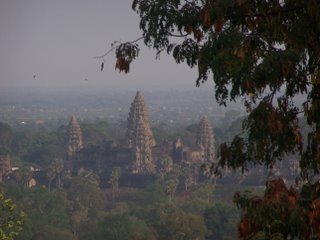
Angkor Wat - viewed from a nearby hill temple at sunset.
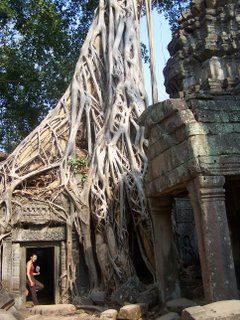
Tomb Raider tree - in the Ta Prohm complex (one the many complexes in the outlying kilometres around Angkor Wat).
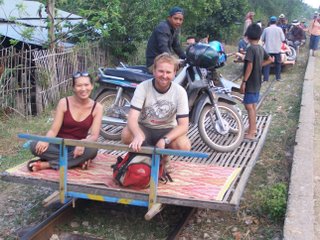
Riding the Bamboo train near Battambang
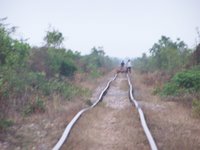
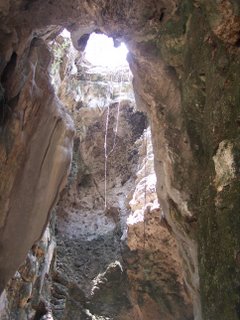
It's thought about 10,000 bodies were dropped into the cave below having first been bludgeoned to death in this particular Khmer Rouge 'killing field' outside Battambang.
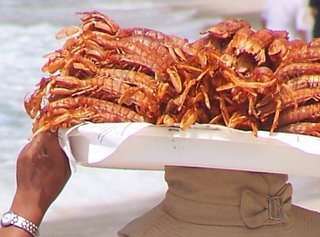
If you like seafood - you'd love Sihanoukville.
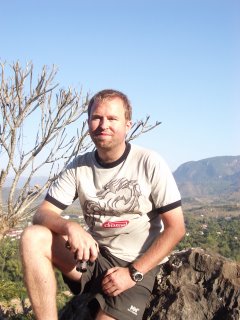
Trying to love the camera whilst looking into the sun.
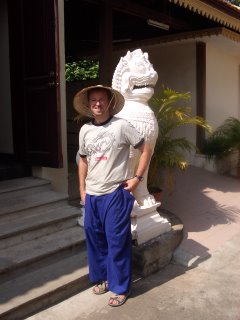
Looking dapper in blue outside the Royal Palace, Phnom Penh. Pulling my shorts as far down to just a little this side of legal I was still displaying an insulting amount too much leg for the king (not in residence) - hence these street cool blue hire trousers to cover my disrespectful knees.
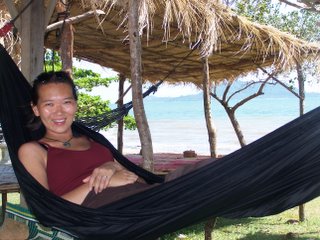
Enjoying cold drinks swinging in hammocks by the beach at Kep.
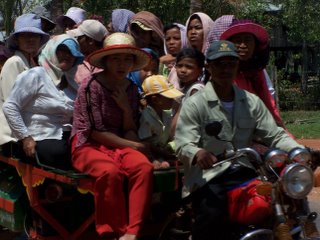
Here it's always possible to squeeze one more person onto the public transport. If the bus is full, the roof has room, if the roof is full - what's wrong with hanging onto the side?
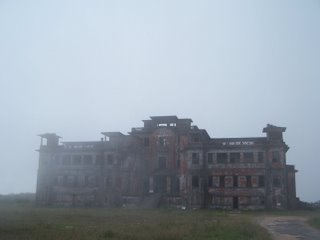
The atmospheric casino and hotel at the Bokor Hill Station.
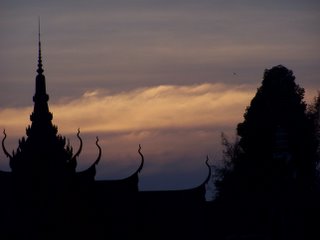
Distinctive Khmer achitecture - here at the National Museum, Phnom Penh
The author, Nick, of our (now) loose leaf photocopied Lonely Planet originates from Watford, but is now married to Kulikar (presumably a Cambodian beauty) and currently they're living happily in Phnom Penh. More than just falling for the delightful Kulikar, we think he's fallen for the whole of Cambodia.
We realised our L.P. was a photocopy - it's quite obvious - but it was very cheap, the quality of the copy is perfect, and it held together well.
Having arrived in Cambodia and after two minutes of usage, the first page to ease smoothly away from the binding (which makes the glue on the back of post-it notes seem incomprehensibly strong) was page 17. It read: 'Itineraries, Classic Route .....". With the rest of the book being used as a paperweight against the efforts of the fan we continued to read page 17 ..... and then to travel around Cambodia in accordance.
Who's to argue with Nick the expert who has not only done all the required research but also documented it for us concisely on page 17. Besides, if we'd done our own research all the pages of our L.P. would have come adrift - it wouldn't be at all useful as a paper weight at just the time we'd need a paper weight more than ever for all the loose pages!
So we started in Phnom Penh (happily coinciding with page 17's proposed start too). Phnom Penh seemed nice enough - a few pleasant eateries along the main Mekong drag, some nice Khmer buildings amongst the nasty concrete ones. (Nick - the dotting Cambodiafile describes it as "The resurgent capital city boasting a beautiful setting on the Mekong River, plus a buzzing scene for dining and drinking").
Fair enough, so next we headed south to Kampot. Kampot proved to be very small, very dark at night (no street lighting), quite run down, but pleasant enough. (Nick said -A relaxed riverside town with a stunning setting and the base to explore beyond).
As suggested we used Kampot as a base, and explored the Bokor Hill Station beyond. "An abandoned hill station set amid dense jungle, blessed with imperious views over the Cambodian coast" ..... It took just over two hours to arrive - driving along what, in 1917, would have been a nice winding hillside road, but now was more like a dried up river bed. As the jeep bashed over another rock we were bumped off the incredibly narrow seats on the back of the pickup, then whip-lashed by the long grasses before reacting just too late to the spiky overhanging brambles. Happily it was atmospheric on arrival, the atmosphere being provided by the large deserted buildings as well as by the thick fog that blocked any imperious views there may have been over the Cambodian coast.
Still in Kampot we hired a scooter to check out Kep (as per page 17) and see the "permanent and poignant reminder of the devastation and destruction wrought on Cambodia during the long years of civil war". Unfortunately we couldn't judge - not having seen the place in it's heyday before it was dismantled by the Khmer Rouge and then looted by the Vietnamese liberators. We did however gently rock in hammocks by the sea and drink some nice chilled drinks.
We moved west to Sihanoukville where Nick promised "brilliant beaches, uninhabited tropical islands, a superb selection of seafood and a happening night scene". The beach was brilliant - so brilliant we stayed on it, and unfortunately didn't check to see if the tropical islands were uninhabited. With all the swimming we were quite tired by the evening, so sadly couldn't verify the happening night scene either. We did see an awful lot of tasty looking seafood - however Sam is allergic and I think seafood is a lot of hard work for something that gives you chronic food poisoning. The beach was enough for us - the water was very shallow and as warm as bathwater, our room was cheap and comfortable, the hotel restaurant was good. A well deserved holiday from the rigors of our holiday.
We took a guess that Sihanoukville was named after the 19 year old Sihanouke - crowned as a puppet king by the French in 1941. Shortly after his coronation he campaigned for independence which, when recognised by Geneva, saw the end of French control of Cambodia (and all of Indochina). Sihanouke then abdicated and ruled Cambodia politically for the next 15 years. Things didn't always go so well however and he was deposed in 1970 leading to his setting up a government in exile in Beijing - this government was nominally in control of a small indigenous revolutionary movement that he nicknamed the Khmer Rouge.
The person most synonimous with the Khmer Rouge is Saloth Sar - aka Comrade Brother Number 1, the French educated Pol Pot. His aims, together with other leaders, was to achieve a utopia formed where the entire population lived in the countryside. The "ruling-classes" and cities were parasites, and there was no place for a national currency and no place for history - 1975 became Year One and the history books became bonfire food.
By Year Three (and eight months) the Democratic Kampuchea had no cities and no currency. Hospitals and schools were emptied and all public officials that were captured were slaughtered. In fact anyone who had gone to school, wore glasses, read a book or had worked in a city was deemed an enemy, and they and their families were either murdered outright or worked to death as slave labour. To save ammunition, beating people to death and disembowelment was encouraged.
Back in Phnom Penh again, we visited the Tuol Sleng Museum. In 1975 the Tuol Svay Prey High School became the largest Khmer Rouge centre of detention and torture in the country (known as Security Prison 21 (S-21)). In three years from 1975, more than 20,000 "high ranking" prisoners were taken here - only seven of whom survived. Many more prisoners of perceived lower rank were bludgeoned at the infamous killing fields of Choeung Ek (near Phnom Penh).
The Choeung Ek killing fields were not the only ones in Cambodia, and at our next stop in Battambang we visited Wat Phnom Sampeau - a hilltop temple used as a Khmer Rouge prison. Skulls and bones remain in a cave beneath a skylight hole from which an estimated 10,000 bodies - all the prisoners - had been dropped.
We'd visited Wat Phnom Sampeau as a day trip from Battambang - we hired bikes and were driven through the back roads of the province. For the return trip we hired a fun - but bottom pain inducing - Norry (aka bamboo train). The train line from Phnom Penh to Battambang is in a shocking state of dis-repair but the locals put it to good use with small, electrically powered, bamboo platforms on wheels. (They're easy to dismantle - should two meet each other - or one meet the oncoming train).
By travelling to Battambang we'd unwittingly broken with Itinerary no. 1 and blindly moved to Itinerary no.2 on page 18. Nick was still on hand however, and he called the seemingly charmless town of Battambang "a charming riverside retreat with a rich legacy of colonial era architecture". We ended up stayed for four days in search of charm, a retreat, or any colonial architecture - then we moved on.
The most surprising thing about Battamang was that, though it's a small and nondescript place, a "riverside retreat", it's Cambodia's second most populous town. In fairness to Nick, we did find a little faded colonial architecture by the river and we found a retreat of sorts in our guest house room (which had satellite TV).
From Battambang we moved to Siem Reap via the express boat along the Stung Sangker river. The ticket was quite expensive ($15), but then the boat on the ticket looked quite expensive ... when we saw our boat the following morning it was obvious why they didn't use it's picture for marketing purposes. Happily the boat only survived for about ten minutes before breaking down - and though the replacement was reliable, it also reliably ran aground every five minutes. Once the driver was able to get the third boat in gear it was good - but unfortunately by this time the 'express' part of the deal had expired, and we stopped for any and all locals who wanted to pop into town. Stopping meant taking the boat out of gear and waiting for ten minutes while the new passengers sorted out their things, said their goodbyes, and were rowed out to meet us. After a further few minutes the boat was back in gear and we were speeding forward.
The boat trip took seven hours, and soon we were disembarking close to Siem Reap on the Tonle Sap Lake (the largest fresh water lake in South East Asia). During the wet season from May to October the lake is fed, via the Tonle Sap River, from the Mekong. During the dry season the river reverses it's direction and feeds the Mekong.
Siem Reap is the town built next to the Angkor temples. There are a lot of expensive hotels and a lot of affluent tourists to fill them - with all the tourist money flowing it's almost inevitable that there's a big industry in begging.
About half the beggars are made up of young children - more than 40% of the population is under 15 years old and it's perhaps unsurprising that Cambodia is a relatively young country. During the Khmer Rouge regime (1975 to 1979) an estimated 2,000,000 people were killed. On the way to their gaining power - in the civil war between 1970 and 1974 - and estimated 1,000,000 died. At their end - and up until around 1989 - a further 500,000 people are believed to have died in the battles with the Vietnamese liberators (followed by the new Cambodian government) and the Khmer Rouge.
The other beggars are formed by people missing various limbs - as many as 40,000 Cambodians have lost limbs due to the proliferation of land mines in the country and Cambodia has the highest number of amputees per capita in the world.
Although today there are several other killers ahead of landmines - snake bites, malaria, tuberculosis, diarrhoea, aids and traffic accidents - landmines still account for approximately 30 deaths a month (a decade ago there were around 300 deaths a month).
Nick suggested that visitors to the temples at Angkor don't stray from the paths - desperate for the toilet or not. He also suggested that the average visitor should find six days to be sufficient time to thoroughly explore the temples. By midday on the second day we'd made our weary way back to our guest house for a well deserved siesta - and didn't make it back.
The main temples at Angkor - Angkor Wat, Bayon and Ta Prohm - we saw on day one. Day two started at 5am (in order to watch the sun rising from behind Angkor Wat). The early start, the highlight temples behind us and the temperature soaring - we saw fit to disregard Nicks usually sound advise.
The temples at the Khmer capital of Angkor were created by successive "God Kings" striving to better their ancestors in size, scale and symmetry - the culmination of which was Angkor Wat. This was completed in 1175, when Angkor had one million residents (compared to London's 50,000). Angkor Wat is still the largest religious building in the world.
We stayed in Siem Reap for five days - though it was the most expensive town in an already comparatively (and surprisingly) quite expensive country. After this time, we did what most other tourists to Siem Reap did, and flew out. We flew to Kuala Lumpur.
There's a great deal of history in Cambodia, with more depressing but dramatic recent history since 1970 than perhaps most countries. The Khmer empire was huge, but now, as Cambodia, the majority of that land has been taken over by Thailand, Laos and Vietnam. Happily the temples at Angkor were returned to Cambodia after 300 years by Thailand early in the twentieth century - as these are certainly the main attraction of Cambodia (especially given the apparent shortage of other attractions). Happily the people make it a nice place to visit - though Nick says if you dig a little deeper into the psyche of Cambodians you can see a sadness .... we didn't do this and all we saw were people who were very much happier, more relaxed, and more smiling than, for example, the Vietnamese.
We have a made up theory that perhaps, because the Vietnamese have a successful history in wars - beating the French, the States and the Khmer Rouge in recent times - maybe they have a trace of arrogance about them. The Cambodians on the other hand don't have this history - their empire is gone and their recent history brutal. Perhaps they have a humility and a 'groundidness' that makes them just happy to be there.
Recently we were watching a French couple being characteristically French .... and with some small considering, we've disregarded the above theory.

0 Comments:
Post a Comment
<< Home